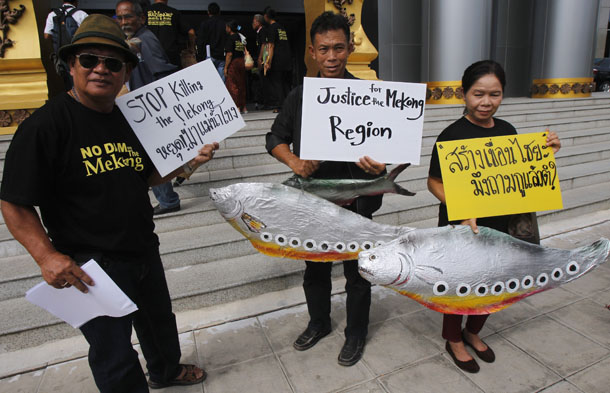
One of the chief financiers of hydroelectric dams planned on Burma’s Salween River is accused of investing in countries where there is “oppression and limited transparency” in order to achieve its objectives.
Having been restricted in its activities at home, the Electricity Generating Authority of Thailand (EGAT) wants to use Burma and Laos as proxy suppliers of electricity via environmentally damaging river dams, the US-based NGO International Rivers told The Irrawaddy.
EGAT is already funding a highly controversial hydropower dam on the Mekong River at Xayaburi in Laos, which is meeting opposition from downstream countries Cambodia and Vietnam, worried about fish losses, and now also Thai communities bordering the river.
“The way this electricity giant is expanding to neighboring countries where there is oppression and limited transparency … shows us very clearly that [it] needs to be reined in and held accountable,” said Pianporn Deetes, the Thailand coordinator for International Rivers.
The warning comes as military tensions and some fighting has erupted in Karen State, through which the Salween River runs, between the Burma Army-backed Border Guard Force (BGF) and ethnic Karen rebels.
The root cause of the fighting is the Naypyidaw government’s bid to secure areas where several river dams are planned, said the chairman of the Karen National Defense Organization, Gen. Ner Dah, in a statement carried by Salween Watch, an international NGO campaigning to preserve the river.
EGAT is the chief financier of the planned Hat Gyi dam, one of the biggest of several proposed along the Salween. Hat Gyi would have a generating capacity of 1,300 megawatts. This volume of new electricity should be a boon to Burma, whose overall national capacity is only about 4,500 megawatts. However, most of the power to be produced at Hat Gyi will be pumped to Thailand under the terms of the existing agreement.
“What EGAT have done on the Salween is part of a general trend to push Thai power projects outside Thailand into neighboring countries, for they cannot easily do this inside Thailand due to strong resistance from Thai communities and civil society,” a legal adviser for EarthRights International, Songkrant Pongboonjun, told The Irrawaddy this week.
“Both the Xayaburi hydropower dam in Laos and the Hat Gyi dam in [Burma] are essentially Thai projects, since EGAT is a key stakeholder of both projects and most of the electricity from the projects will be sent to Thailand.
“All they care is to invest in the area where they are met with least resistance,” Songkrant said.
Ner Dah said the Burmese Army is using BGF troops and also supporting them logistically to “clear the area so that they can start [the] dam project.”
“Karen civilians do not support [the hydropower project] because they feel they will not benefit,” he said.
EGAT is under pressure to find alternative sources of energy because the military-led government in Bangkok is concerned that the country has become too dependent on expensive natural gas.
Gas fuels about 70 percent of Thailand’s electricity generation and about 25 percent of this is imported from Burma. The level of imports will increase over the next two years as the Zawtika offshore field in the Gulf of Martaban operated by Thailand’s state-owned PTT Exploration of Production reaches full output.
More than 90 percent of electricity produced by the Xayaburi dam on the Mekong will be bought by EGAT, according to its agreement with the Lao government. The dam is scheduled to have a generating capacity of 1,280 megawatts.
But opponents say the Xayaburi dam will disrupt water flows and the migration and breeding of fish, which hundreds of thousands of people depend upon for food.
A study of business risks in Laos by British assessors Maplecroft spotlighted “pervasive corruption” within the political system and the economy. Although the environment was coming under growing pressure from natural resource exploitation—as is happening in Burma—there was also a “suppression of freedom of expression” in the country.
“Laos performs poorly on most indicators regarding the protection of basic human and labor rights,” Maplecroft said.
But while little can be achieved in Laos to stop Xayaburi, an international coalition of opponents under the banner Save the Mekong is seeking an injunction in the Thai courts to suspend EGAT financing of the dam. The coalition alleges that EGAT failed to consult Thai communities along the Mekong and has ignored safety standards.
In its most recent assessment, Salween Watch identified the Chinese state-owned Sinohydro Corporation in a partnership with EGAT that had been given renewed approval by Naypyidaw to proceed with the Hat Gyi dam.
Dams on the Salween were first discussed at the end of the 1990s.
“Very little information about the [Salween] projects has been disclosed to the public. Unrest in the ethnic states of Burma has also hampered independent efforts to gather information,” Salween Watch said.
Calls to EGAT in Bangkok by The Irrawaddy to clarify the state agency’s current involvement on the Salween failed to obtain any answers. Calls were repeatedly lost during inter-office transfers.
“The lawsuit filed against EGAT’s involvement in purchasing electricity from the Xayaburi dam on the Mekong River in Laos demonstrates that EGAT cannot continue these actions without consequences,” International Rivers’ Pianporn told The Irrawaddy.
“The company needs to examine its behavior as it might [soon] need to comply with Thai laws when operating abroad.”
Source: http://www.irrawaddy.org/business/thai-power-firms-business-tactics-use-burmas-weak-laws.html


